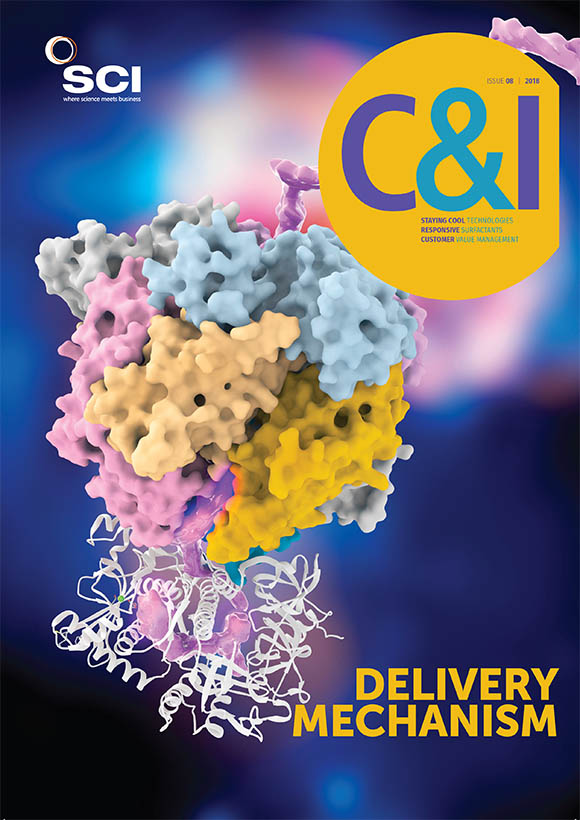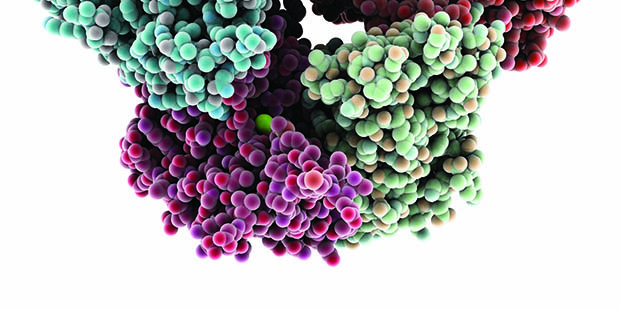Tiny extracellular vesicles called exosomes could one day prove useful everywhere from diagnostics for prostate cancer and preterm births to drug delivery and treatment of disease, reports Katrina Megget
Microscopic membranous vesicles floating outside of cells were first discovered 50 years ago; 30 years later, a subset of these was coined exosomes. At the time, these membrane bubbles were believed to be nothing more than a cellular waste disposal mechanism. But within the past decade, extracellular vesicles – and exosomes in particular – have piqued scientists’ interests, resulting in a research boom.
Image: Laguna Design / Science Photo Library
In 2006, there were just 115 publications referencing exosomes; by 2015, this number had mushroomed to 1010. Today, a PubMed search brings up more than 7500 publications. Consulting firm Grand View Research estimates that the global exosome market could reach $2.28bn by 2030.
The interest in exosomes has been driven by the new finding that exosomes are more than just a waste disposal system – they are also a means of communication between cells and have the ability to carry cargos such as proteins and mRNA, suggesting there could be potential medical applications. ‘Currently, research into exosomes and other extracellular vesicles is very strong,’ says Jason Webber, Prostate Cancer UK research fellow in the Division of Cancer and Genetics at Cardiff University. ‘I think this field of research will continue to grow and I believe we’ll also see greater clinical application of exosomes and a drive towards research exploring the therapeutic potential of exosomes.’
What are exosomes?
Exosomes are best described as extracellular vesicles – essentially membrane sacs – formed by the inward budding of the membrane of intracellular compartments known as multivesicular bodies (MVBs) or multivesicular endosomes (MVEs). They are released from cells when MVBs fuse with the cell’s plasma membrane, releasing its contents outside the cell. These vesicles, made of a phospholipid bilayer and ranging between 40nm and 150nm in diameter, are found in all biological fluids including blood, urine, saliva, bile, semen and breast milk.
Scientists have become excited by exosomes because of the recent discoveries of their biological function and the finding that they carry a variety of cargo, including proteins, lipids, metabolites, messenger RNAs, microRNAs, which regulate gene expression, and even DNA, explains David Carter from Oxford Brookes University and president of the UK Society for Extracellular Vesicles. ‘Exosomes were previously thought to be a mechanism for removing unwanted cellular material, but it’s now known that exosomes can be picked up by other cells, which can then utilise the cargo that is delivered. This leads to phenotypic changes in these recipient cells,’ he says. ‘Exosomes are therefore an important part of the dialogue that cells use to communicate with one another.’
Indeed, research has found that exosomes have a plethora of biological roles. Studies have revealed that exosomes have a role in immune responses, specifically that exosomes from B lymphocytes can activate T lymphocytes, while those from dendritic cells activate T cells and promote antitumor responses in mice. Meanwhile, other research in 2018 found that cancer cell-derived exosomes carrying PD-L1 proteins can shut down the immune response by deactivating T cells.
Exosomes have also been found to be involved with blood vessel formation, tissue repair, communication within the nervous system, regulation of inflammation, the promotion of insulin resistance and diabetes, Alzheimer’s disease and the spread of cancer to other parts of the body. Furthermore, specific receptors and ligands on their surface mean exosomes target particular recipient cells at distant sites in the body.
There is still much to learn about these unique signalling vesicles – and even some contention around the use of the word ‘exosomes’ given that there are other types of extracellular vesicles with similar characteristics, says Clotilde Théry, team leader of exosomes and tumour growth at France’s Institut Curie. As such, she argues that it has not yet been ‘convincingly demonstrated’ that exosomes specifically have greater clinical potential than other extracellular vesicles.
That said, interest in the medical potential of exosomes is growing. Based on their unique behaviours, exosomes have the potential to be used as diagnostic biomarkers for disease, as a drug delivery mechanism and even as a therapeutic drug. ‘The unique and innate cell adhesion, recognition and intercellular signalling capability of exosomes serve as a platform to dramatically change human medicine,’ says Steven Stice, co-founder, CEO and chief scientific officer of Georgia, US-based biotech firm ArunA Bio.
|
$2.28bn |
|
Exosomes carry a variety of cargo including proteins, lipids, metabolites, messenger RNAs, microRNAs and DNA |
|
7500 |
|
US-based ArunA Bio is planning preclinical studies of its exosome platform in epilepsy, multiple sclerosis and spinal cord injuries later in 2018, and is aiming to have a product on the market in five years |
Biomarkers for disease
One of the most hotly anticipated healthcare applications for exosomes is as a diagnostic tool. This is based on the fact that exosomes are easily available in body fluids, while molecules on exosomes can identify which parent cell they came from. For instance, research suggests exosomes could act as diagnostic biomarkers to indicate the severity of traumatic brain injuries (TBIs) based on certain protein levels carried by brain cell exosomes and whether individuals with TBIs were at risk of developing chronic symptoms. Alzheimer’s disease could also benefit from an exosome diagnostic after researchers found that exosomes carrying the toxic protein amyloid-beta to nearby cells could be the main mediator for the spread and progression of the disease.
Similar diagnostic research is being done in cancer after it was found that cancer cells release more exosomes than healthy cells, which contribute to tumour progression in a variety of ways. This finding could provide a means to detect cancers in blood or urine and potentially remove the need for invasive biopsies, says Webber.
Building on exosome research by Cardiff University colleague Aled Clayton, Webber is investigating how prostate cancer exosomes enhance tumour growth. Webber’s particular interest is in the function and regulation of fibroblast cells, which maintain normal body functions such as wound healing but can also be hijacked for cancer progression. Webber and Clayton discovered that cancer exosomes have a major role in fibroblast function. ‘Once these fibroblasts become hijacked [by cancer exosomes], they alter the surrounding environment to facilitate tumour growth,’ Webber says.
‘By gaining an improved understanding of the mechanisms that regulate disease progression, I have identified several new cancer markers that are present on cancer exosomes, and I’m currently developing several proof-of-concept tests involving the use of exosomes to identify patients with prostate cancer.’ A diagnostic that can identify prostate cancer patients early, particularly those with aggressive forms of the disease, would improve lives, he says. Another British researcher working on an exosome-based diagnostic is Rachel Tribe from King’s College London. Tribe’s research, funded by the Action Medical Research charity, is developing a screening test to identify pregnant women who have an increased risk of premature birth. Tribe’s team, with collaborator Carlos Salomon at the University of Queensland, Australia, was the first to report on the presence of exosomes in human cervico-vaginal fluid. The team is now investigating where the exosomes are released from – possibly the reproductive tract epithelium, which acts as a first-line of defence against microbes.
The team believes the exosomes are important in defending against mild infections by alerting neighbouring cells to bacterial invasion. Infections of the vaginal tract are thought to be a possible cause of premature birth. ‘We anticipate exosomes will be useful in understanding the causes of spontaneous preterm birth and we hope to identify a specific exosome signature that could be used as a biomarker to predict the risk of spontaneous pre-term birth,’ Tribe says.
Specifically, Tribe is analysing the cargo of the exosomes and looking for protein and microRNA profiles early in pregnancy that could predict pregnancy outcome. So far, she says, differences, early in pregnancy, have been identified in the protein and microRNA signature of exosomes from women who go on to deliver preterm, compared with those who deliver at term. ‘These differences appear to emerge as early as 10-16 weeks of pregnancy,’ Tribe says, adding that the results are now being validated in a larger group of pregnant women.
Exosomes deliver
The second big area of medical interest in exosomes is the possibility of drug delivery. Not only do exosomes have the ability to target specific cells, their cargo-carrying skills opens the door for delivery of nucleic acid medicines in the form or RNAs and DNA, which have struggled to be administered as medicines in the past.
Roche is one Big Pharma company that has already staked a claim to explore this route having recently signed a multi-million-dollar deal with Boston, US-based biotech PureTech Health. The deal will allow Roche to advance PureTech’s milk-derived exosome platform technology for the oral administration of Roche’s antisense oligonucleotide platform, which targets messenger RNA and inhibits gene targets. According to Bharatt Chowrira, PureTech’s president and chief of business and strategy, the hope is that the exosomes will be applied to multiple products. ‘Roche is making a big commitment, but this commitment validates the approach and shows the immense potential that our exosome platform has.’

Derived from milk, PureTech’s exosomes are essentially borrowing from nature to solve the problem of administering nucleic acid medicines, explains the firm’s chief scientific officer Joseph Bolen. ‘Traditional packaging of RNA as a medicine often sees it go to the liver, which isn’t necessarily useful for other parts of the body,’ he says. ‘Milk exosomes are designed to be secreted in milk and orally absorbed in the infant, which shows the stability of these exosomes; they’re not degraded by digestion, unlike other exosomes. What we’re doing is taking that stability of the exosomes and looking to load them with cargo we deem interesting that could be used as therapeutics. We’re generating oral therapeutics from modalities not previously bioavailable and that’s a big thing in medicine.’
Meanwhile, other researchers are looking at the therapeutic value of exosomes themselves. ArunA Bio, for instance, has been investigating the regenerative effects of exosomes derived from neural stem cells. In research published in April 2018, the firm found that AB126 exosomes – a new class of cell-free biologics – improved tissue and functional recovery of pigs that had experienced ischemic stroke (R. Webb et al., Stroke, 2018, 49, 1248). The firm found that the exosomes were neuroprotective, eliminated intracranial haemorrhage in ischemic lesions, improved behaviour and mobility, decreased cerebral infarct volume and brain swelling, and led to significant improvements at both tissue and functional levels, which looked at gait and stride length.
ArunA’s proof-of-concept research with pigs follows research in mice that also showed that the neural-derived exosomes had neural protective and regenerative features. The company has established that the exosomes have the ability to cross the blood-brain barrier and are internalised by neural tissue, delivering their cargo to the central nervous system. The AB126 exosomes have been found to target the site of injury in the brain and enhance the system’s neuroprotective mechanisms, Stice says. ‘We believe that there are multiple benefits both to the cargo they carry and very likely the unique signalling mechanisms that are innate to AB126,’ Stice explains when asked how the exosomes elicit the protective response. ‘We are not pursuing a reductionist approach, where one molecule would generate all these impressive results,’ he adds.
The company, which has the ability to manufacture the exosomes at clinical scale with lot-to-lot consistency, is also looking at AB126 exosomes as a drug-delivery combination platform whereby they could deliver specific antibodies, nucleic acids and other large molecules across the blood brain barrier without toxic side effects. ‘The inherent tropism/cell specificity of AB126 and our platform are set up to change how we think about exosomes… This is a game changer for the industry and a life-changer for patients,’ says Stice. The company is planning preclinical studies in epilepsy, multiple sclerosis and spinal cord injuries later in 2018, and is aiming for a product to hit the market in five years.
Besides the regenerative effects, some researchers are exploring the disease-spreading effects of the extracellular vesicles. By identifying the genes and molecules involved in the production and secretion of exosomes involved in disease spread, new potential drug targets could be discovered. A team at the US University of Wisconsin-Madison, for example, has found that the release of tumour-promoting exosomes by breast, pancreatic and lung cancers is stimulated by elevated cytoplasmic calcium levels and also depends on elevated levels of the calcium-binding protein Munc13-4, present in cancer cells primed for metastasis.
‘We suggest that Munc13-4 represents a potential drug target for cancer intervention to interfere with tumour metastasis,’ says Thomas Martin, Wasson professor of biochemistry at the University of Wisconsin-Madison. The future for exosomes is ‘incredibly exciting’ and it’s only a matter of time before they make their way to the pharmacist’s shelf, Carter says. Before then, however, he acknowledges that: ‘a lot of questions have not been completely answered.’






